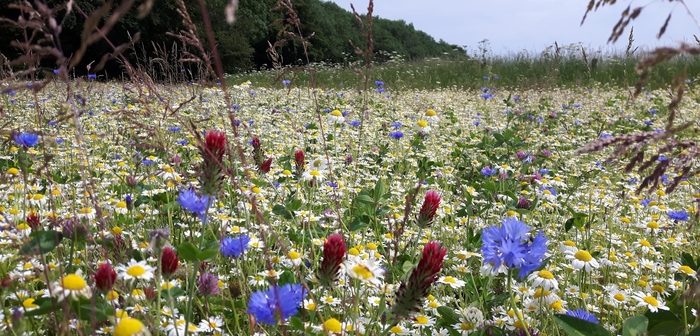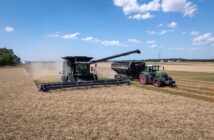Yorkshire farming environment specialist, Mark Richardson, is pioneering a new use of wildflower margins to attract bumblebees to the bean fields of East Yorkshire-based JSR Farms – with the intention of improving pollination that will increase crop yields.
He’s believed to be the first ever to sow an Operation Pollinator Annual Wildflower Mix in the autumn around fields that will be destined for planting with beans next spring.
“The aim is for the flower mix to provide a good source of early pollen and nectar that will attract the bees into the fields, where they will be ready for when the beans come into flower,” explains Mark, who has worked as JSR Farms’ for 36 years.
“For bean pollination you want to encourage long-tongued species of bumblebees that are more effective at working in the flowers; short-tongued bees tend to bite through the underside of the flower to rob the pollen – without the benefit of pollination.
“Insect monitoring on the farm has shown that the high proportion of Crimson and Red Clover in the Operation Pollinator Annual Wildflower Mix has been particularly attractive for long-tongued bumble bees,” he adds.
The initiative follows published research by the Centre for Ecology and Hydrology and reported by the Campaign for the Farmed Environment, that highlighted integrating environmental management alongside commercial farming could enhance overall farm productivity and profitability – with beans the crop that benefitted most from increased pollination and natural predator pest control.
Mark pointed out that as a one-year mix the Annual Wildflowers work well on short-term rented land, where growers may not want to plant more expensive long-term perennial mixtures. “It gives you flexibility to move the plot to fit with crop rotations. It doesn’t take a lot of land, but it’s doing a lot of good.”
He advocated that the Annual Wildflowers give a quick return, with a high delivery of pollen and nectar for bees and other insects in a short time scale, compared to perennial mixtures that may not get highly productive flowering until their 2nd or 3rd year.
The Annual Wildflower Mix is also sown around some winter oilseed rape crops. The mix starts to flower as the OSR finishes, which gives pollinating insects somewhere to move to after the oilseed rape and provides them with an essential season-long food source.
Furthermore, Mark has successfully used the mix in awkward shaped field corners that don’t fit with modern large scale machinery and, with correct management, reports the flowers have successfully naturally regenerated to come again well for a second year.
The Annual Wildflower Mix also includes Phacelia, which independent monitoring by leading pollinating insect ecologist, Mike Edwards, has reported being particularly attractive and valuable to honey bees on the farm.
In addition to the farm’s Higher Level Stewardship (HLS) environmental areas, where they have floristically enhanced and legume areas, there are many additional voluntary options, which includes the Operation Pollinator Annual Flower Mix.
Furthermore, Mark is enthusiastic in making more use of low or zero cost environmental assets, for example not mowing grass margins until the end of the year, allowing wildflowers to flower and re-seed, as well as gathering local wildflower seed resources, to supplement meadows and margins on the farm.
“There’s a huge ecological resource around every field and along every farm roadside – but too often it’s just mowed or sprayed to a barren strip. Leaving them to grow up and flower costs nothing and adds immensely to the farm’s overall mosaic of habitats and the real environmental value.”
JSR Farms crop around 3400 hectares of arable production a year, within a 20 mile radius of the home farm, at Southburn in East Yorkshire. Crop production is based on a six-year rotational model, dominated by high yielding wheat, along with barley and oilseed rape. The company is also a renowned producer of seed potatoes. Pulse crops, particularly vining peas, along with field beans, complete the break crops.
The company’s director of arable production, Philip Huxtable, points out that keeping the farm’s environmental balance in credit has become a trademark of the business and features strongly within its ethos; ‘Excellence in reputation’ is a core value of the whole operation.
Approximately 10% of the farming area has been in environmental schemes, along with areas of land managed for environmental gain where it will also provide agronomic benefits. “Wildlife habitat is encouraged by the planting of trees, hedges, grass margins, wild bird mixtures, game strips, beetle banks and the creation of ponds and reservoirs,” he cited. JSR has been an active participant of Syngenta’s Operation Pollinator initiative for more than a decade.
Over the years the company has won two prestigious Silver Lapwing Awards and became a LEAF Demonstration Farm in 2001 – aiming to highlight to a wider audience the benefits of Integrated Farm Management (IFM) for the sustainable production of safe and healthy food, whilst caring for animal welfare and the countryside.
Philip highlights the company is rightfully proud of its commitment to biodiversity. “Incorporating wildlife management into the everyday running of the business is not just a luxury, it’s a necessity,” he says. “We acknowledge that our arable crops offer a habitat in their own right, so Integrated Farm Management is practiced across all our farms and throughout the rotation.
“We consider the interface between environmental options and commercial crops is indistinct. Our commitment to sustainable agriculture is essential to the success of any future agri-environmental policy.”
Mark Richardson’s Top Tips for Annual Wildflower sowing success:
- Start with a stale seedbed
- Broadcast the seed on or at the soil surface
- Roll the seedbed well after sowing
- Sow through to the end of September
The Syngenta Operation Pollinator Annual Wildflower Mix is available from environmental seed specialist, Kings, at a special offer cost of £35 per 4 kg pack, sufficient to create up to one hectare of attractive new habitat for bees and pollinating insects.




